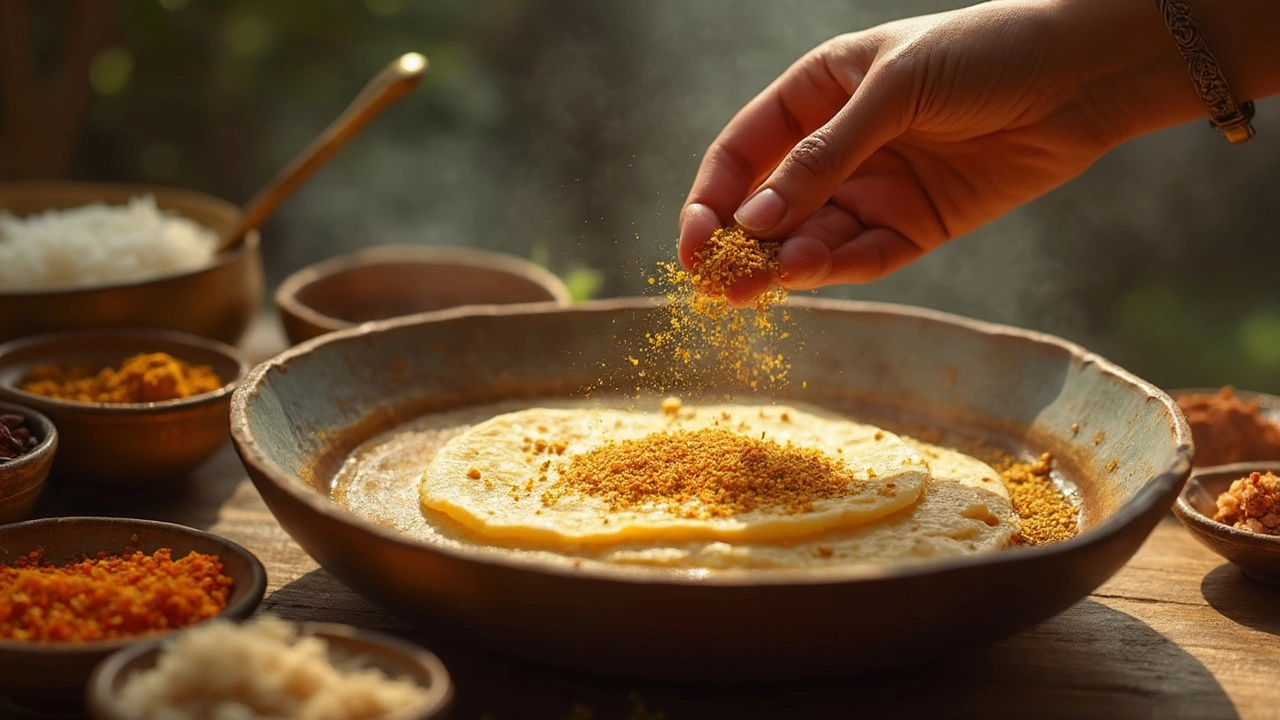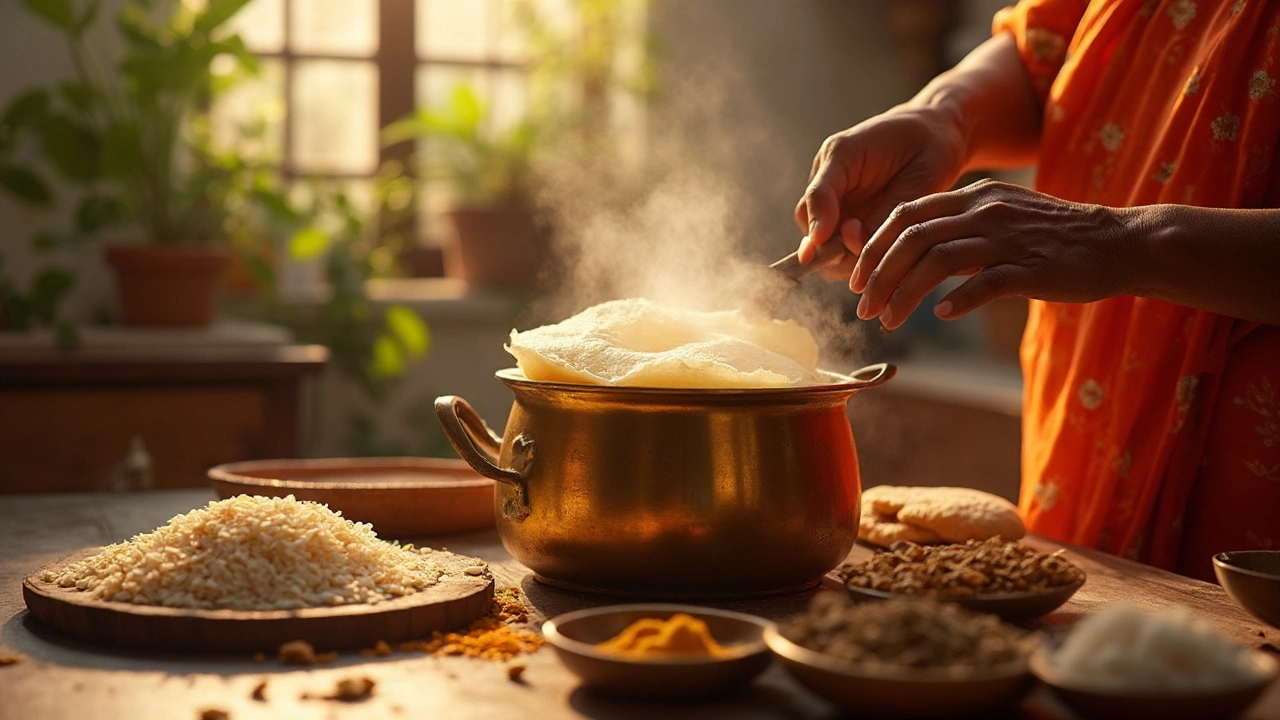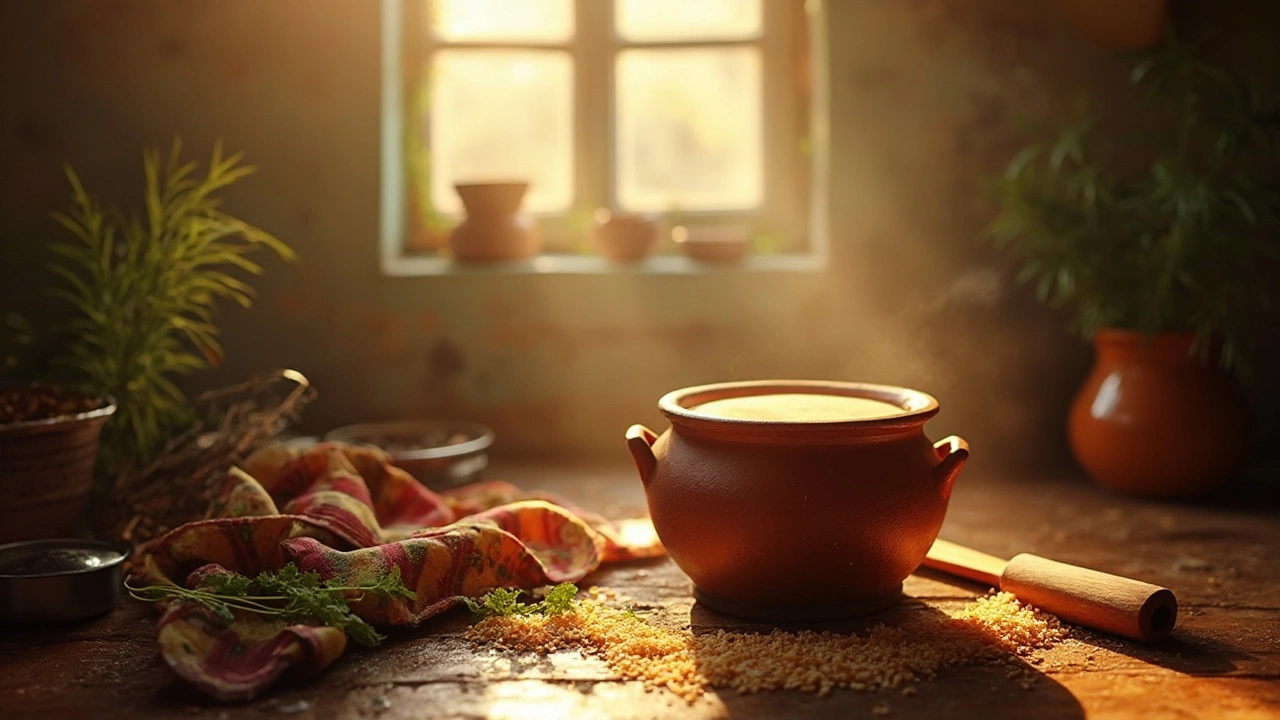Fermentation
When working with Fermentation, the natural process where microbes convert sugars into acids, gases, or alcohol, adding flavor and texture to food. Also known as fermenting, it’s essential to many Indian dishes. Fermentation isn’t just a fancy term – it’s the secret behind the tangy bite of dosa, the fluffiness of idli, and the depth of many pickles.
Why Fermentation Matters in Indian Kitchens
One of the most common ways home cooks use fermentation is in Dosa Batter, a fermented rice‑and‑lentil mixture that forms the base for South Indian crepes. Also known as dosa dough, it relies on a balanced microbial community to create the airy texture you see when the batter pours onto a hot pan. Fermentation supplies the carbon dioxide that puffs the batter, while the acids mellow the rice flavor, making each bite crisp yet soft. If you’ve ever wondered why an overnight‑rested batter tastes so different from a fresh mix, the answer lies in this micro‑metabolism.
Another player that jumps out of the fermentation picture is Curd, a milk‑based product made by fermenting dairy with lactic‑acid bacteria. Also called yogurt, curd serves as a starter culture for many batter recipes, especially dosa and idli. The bacteria in curd speed up the breakdown of starches, giving the batter a gentle sour note and a smoother consistency. Adding a spoonful of curd to your rice‑lentil mix can cut the waiting time from 12 hours to just a few, a trick many busy cooks swear by.
While batter and dairy get most of the spotlight, the humble practice of Dal Soaking, pre‑soaking lentils or split peas in water before cooking plays a surprisingly supportive role in fermentation. Soaking softens the outer seed coat, allowing enzymes to kick in earlier, which in turn reduces cooking time and improves digestibility. When you combine soaked dal with a fermented batter, the dal’s natural sugars become easier for microbes to feed on, boosting the overall fermentation speed and flavor development.
Beyond these three, many Indian condiments benefit from the same principles. Take chutney, for example: a quick‑pickled blend of herbs, spices, and a splash of vinegar relies on acidic fermentation to stay fresh and develop a layered taste. Understanding how fermentation affects shelf life helps you store chutney in the fridge longer without losing that zing. Even when you’re not making a pickle, a dash of fermented lemon juice or a spoonful of fermented mango pulp can brighten a curry the same way a long‑fermented batter brightens a dosa.
All these examples show a clear pattern: Fermentation creates connections between ingredients, cooking methods, and final flavors. It encompasses the creation of dosa batter, requires curd as a starter, and is accelerated by proper dal soaking. The process also influences side dishes like chutney, showing how one technique can ripple through an entire meal.
For beginners, the biggest hurdle is timing. Want a quick fix? Use curd to jump‑start dosa batter, and soak dal for at least 30 minutes to cut cooking time. Want a deeper flavor? Let the batter sit for 12‑14 hours at room temperature, then refrigerate overnight before cooking. Want to keep chutney fresh? Store it in a clean jar with a thin layer of oil on top; the oil creates an anaerobic barrier that slows down unwanted bacterial growth.
Each article in the collection below dives deeper into one of these topics. You’ll find fast methods for fermenting dosa batter without an overnight wait, scientific explanations for why curd transforms texture, and practical tips for soaking dal to improve both nutrition and flavor. Whether you’re looking for a shortcut, a science‑backed reason, or a new twist on a classic, the posts ahead cover the full spectrum of Indian fermentation.
Scroll down to explore quick dosa tricks, the role of curd in batter, and how simple dal soaking can boost your kitchen’s fermenting power – all designed to help you master the art of Indian fermentation today.

Perfect Dosage: How Much Baking Soda To Use in Dosa Batter for Fluffy Results
Find the right amount of baking soda to add to dosa batter for fluffy dosas. Practical tips, mistakes to avoid, and science behind the results.

Fenugreek in Dosa Batter: The Real Reason It’s Never Left Out
Ever wondered why fenugreek seeds show up in almost every dosa batter recipe? This article digs into what fenugreek actually does for dosa, from taste to texture to health. Get clear answers on how much to use and whether you can skip it. You'll pick up a few practical tips that make your batter better. Even if you're new to dosa-making, you'll find solid reasons never to leave fenugreek out.

Speed Up Your Dosa Batter Fermentation Without Using Yeast
Unlock the secret to speeding up dosa batter fermentation without relying on yeast. This guide explores practical methods embraced by seasoned home cooks. Get hands-on advice on ingredients, understanding ideal fermentation, and storage tricks. Whether you're a busy parent or a foodie, discover ways to make your dosa batter ready in less time.

Speedy Tips to Ferment Dosa Batter Using Natural Ingredients
Discover practical tips to speed up the fermentation of dosa batter using natural ingredients. This article provides step-by-step methods for perfect dosa batter, highlighting ways to optimize the process without sacrificing flavor. Learn about the role of temperature, ingredients, and time to create delicious, crispy dosas. Unlock the secrets of traditional techniques enriched with modern insights.

10 Secrets to Speed Up Dosa Batter Fermentation Naturally
Speeding up dosa batter fermentation can be a game-changer for those craving this delicious South Indian staple but are short on time. This article unveils natural methods to boost the fermentation process, ensuring a fluffy, soft dosa without any chemical shortcuts. From choosing the right ingredients to optimizing room temperature, each tip is practical and easy to implement. Whether you're a seasoned chef or a curious foodie, these insights will enhance your dosa-making skills significantly.

Speed Up Your Dosa Batter Fermentation: Simple Natural Hacks
Fermenting dosa batter can take time, but with a few natural tricks, you can speed up the process. From altering your soaking methods to rediscovering the benefits of the sun, these are easy adjustments you can make in your own kitchen. Understanding the right temperature and environment is key to ensuring perfect fermentation. These tips will help you enjoy delicious dosas with less wait time. Say goodbye to delays and hello to quick, tasty dosas!

Quick Dosa Batter Fermentation: Tips to Get Soft Dosas Fast
Discover how to speed up dosa batter fermentation with practical tips to enjoy soft, delicious dosas in less time. The article explores factors affecting fermentation, including climate, ingredients, and kitchen hacks. It provides solutions to common pitfalls and suggests simple tweaks to traditional methods. You'll find easy steps to optimize batter preparation for those craving quick, fluffy dosas without the wait. Perfect for both beginners and seasoned cooks eager for efficient results.

Boost Dosa Batter Fermentation Naturally Without Yeast
Fermenting dosa batter naturally can be a bit tricky, but with some practical tips, you can get fluffy dosas without using yeast. Understand how to harness the right temperature, use age-old fermenting vessels, and even leverage natural ingredients. Discover effective ways to prepare batter that stays fresh and yields perfect results every time. Transform your kitchen into a fermentation haven with these simple and natural tips.

Quick Dosa Batter Fermentation Hacks Without Yeast You Must Know
Fermenting dosa batter without yeast can be a bit tricky since yeast plays a significant role in the rising process. However, several hacks can simplify the fermentation process, making it quicker and more reliable. Utilizing natural ingredients you might already have at home can save time and improve results. By understanding how temperature and environment play a role, you can ensure your dosa batter ferments perfectly every time. Discover these simple yet effective tricks to get your dosa batter ready without relying on yeast.

Simple Secrets to Quick Dosa Batter Fermentation Without Yeast
Creating the perfect dosa batter without using yeast can be a challenging task, especially when you're short on time. This article reveals effective techniques and easy-to-follow tips to achieve ideal fermentation for dosa batter. Learn how using the right ingredients and storage methods can enhance the fermentation process. Discover surprising hacks that ensure fluffy dosas quickly and without the need for yeast. Explore the secrets of achieving that perfect batter consistency and taste.

Quickly Ferment Dosa Batter Without Yeast
Fermenting dosa batter without yeast can be a challenge, but with a few tricks, you can speed up the process. Learn how temperature, ingredients, and simple methods play crucial roles in quick fermentation. Discover exciting facts about dosa batters and tips to make the perfect dosa at home. Whether you're new to cooking or a seasoned chef, these insights can make a difference in your dosa-making journey.

Mastering Dosa Batter Fermentation Without Yeast
Fermenting dosa batter without yeast is an art that brings a unique flavor and texture to this traditional dish. Learn how to choose the right ingredients, handle fermentation challenges, and achieve perfect results every time. This guide provides helpful tips on mastering the process, including dealing with different weather conditions and storing extra batter. Dive into the science and simplicity behind making consistently delicious dosas at home.